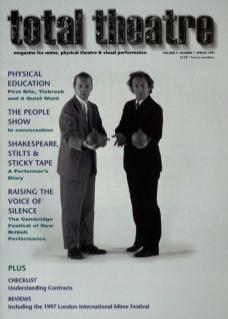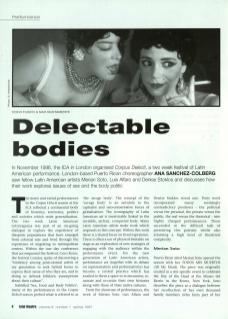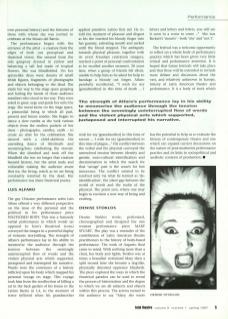The many and varied performances in the Corpus Delecti season at the ICA reflected a continental body of histories, territories, politics and societies which resist generalisation. The two-week Latin American extravaganza was part of an ongoing dialogue to explore the experience of diasporic populations that have emerged from colonial rule and lived through the experience of migrating to metropolitan centres. Within the one-day conference that accompanied the festival, Coco Fusco, the Festival Curator, spoke of discovering a ‘tendency among postcolonial artists of my generation to seek hybrid forms to express their sense of who they are, and in doing so debunk folkloric assumptions about their culture’.
Subtitled 'Sex, Food and Body Politics', many of the performances in the Corpus Delecti season probed what is referred to as 'the savage body'. The concept of the 'savage body' is an antidote to the capitalist and neo-conservative forces of globalisation. The iconography of Latin American art is inextricably linked to the invisible, archaic, conquered body. Many Latin American artists make work which responds to this concept. Within this work there is a shared focus on lived experience. There is often a use of physical brutality on stage as an exploration of new strategies of engaging with the audience within the performance event. For the new generation of Latin American artists, performance art (together with its debate on representation and performativity) has become a central practice which has availed to them a space to re-encounter, re-narrate and re-create their own histories along with those of their native cultures.
From the showcase of performances, the work of Merian Soto, Luis Alfaro and Denise Stoklos stood out. Their work incorporated many seemingly contradictory positions – the political versus the personal, the private versus the public, the real versus the theatrical – into highly charged performances. These succeeded in the difficult task of presenting this polemic whilst also attaining a high level of theatrical complexity.
Merian Soto
Puerto Rican artist Merian Soto opened the season with her Todos Mis Muertos (All My Dead). The piece was originally created as a site-specific event to celebrate the Day of the Dead at the Museo del Barrio in the Bronx, New York. Soto describes the piece as a dialogue between her recollection of her own deceased family members (who form part of her own personal history) and the histories of those with whom she was invited to celebrate at the Museo del Barrio.
The performance began with the entrance of the artist – a creature from the edges of both our perceptual and theatrical vision. She entered from the side gangway dressed in yellow and balancing a tall hat made of tropical flowers. She was blindfolded. On her apron-like dress were dozens of small fetish figures, fragments of photographs and objects belonging to the dead. She made her way to the stage space grasping and feeling the hands of those audience members who stood in her way. They were asked to greet, urge and guide her onto the stage. She stood alone on the stage space, a primordial being in which all past, present and future resides. She began to dance a slow rumba as she took various objects from the endless pockets of her dress – photographs, candles, earth – to create an altar for the celebration. She danced with a child-skeleton the unending dance of life/death and mourning/loss; celebrating the eternal. When she disrobed and took off the blindfold she was no longer that creature beyond history, but the artist nude and vulnerable making the audience aware that we, the living, watch as we are being constantly watched by the dead. Her performance was sheer theatrical poetry.
Luis Alfaro
The gay Chicano performance artist Luis Alfaro offered a very different perspective on the issue of the personal and the political in his performance piece Politicised Body. This was a furiously verbal performance in which words (as opposed to Soto's theatrical icons) conveyed the images in a powerful display of virtuosic storytelling. The strength of Alfaro's performance lay in his ability to mesmerise the audience through the tension between the seemingly uninterrupted flow of words and the violent physical acts which supported, juxtaposed and interrupted his narrative. Words were the conveyors of a history inflicted upon his body which mapped his personal voyage on stage. This voyage took him from the recollection of killing a rat in the back garden of his house in the Latino Barrio in LA, to the moment of terror inflicted when his grandmother applied primitive Latino first aid. He retold the moment of pleasure and disgust as she inserted his bloody finger into her gummy, salivating mouth and sucked until the blood stopped. The ambiguity towards physical pleasure, together with its overt Freudian castration imagery, reached a point of personal confrontation as he recalled another moment, twenty years later, when a group of friends fell silent, unable to help him as he asked for help to bandage a bloody cut finger. Alfaro painfully recollected, ‘I wish for my [grandmother] in this time of death... I wish for my [grandmother] in this time of sorrow... I wish for my [grandmother] in this time of plague...’ His conflict between the verbal and the physical conveyed the unresolved tension between identity and gender, socio-cultural identification and discrimination in which the search for that 'savage' past is the search for lost innocence. The conflict seemed to be resolved only via what he termed as 'deidentification', the silent gap between the world of words and the realm of the physical. The point zero, where one may begin to envision a new way of being and existing.
Denise Stoklos
Denise Stoklos wrote, performed, choreographed and designed the one woman performance piece Mary Stuart. The play was a reminder of the contribution of Latin American theatre practitioners to the history of body-based performance. The work of Augusto Boal came to mind. With nothing more than a chair, her body and lights, Stoklos was at times a beautiful victimised Mary, then a split second later she became a dog-like, physically distorted oppressor Elizabeth. The piece explored the ways in which the theatrical paradox can be used to reveal the process of historisation and the degree to which we are all subjects and objects within this process. The actress turned to the audience to say ‘Mary, she wrote letters and letters and letters, you will see it soon in a scene to come.’ She was Beckett's ‘mouth' – both 'she' and 'not I'.
The festival was a welcome opportunity to reflect on a whole body of performance practice which has been given very little critical and performance attention. It is hoped that future festivals will take place and that these will be extended to include more debate and discussion about the vast, and relatively unknown in Europe, history of Latin American theatre and performance. It is a body of work which has the potential to help us re-evaluate the history of contemporary theatre and one which can expand current discussions on the nature of post-modernist performance practice and its links to sociopolitical and aesthetic contexts of production.


